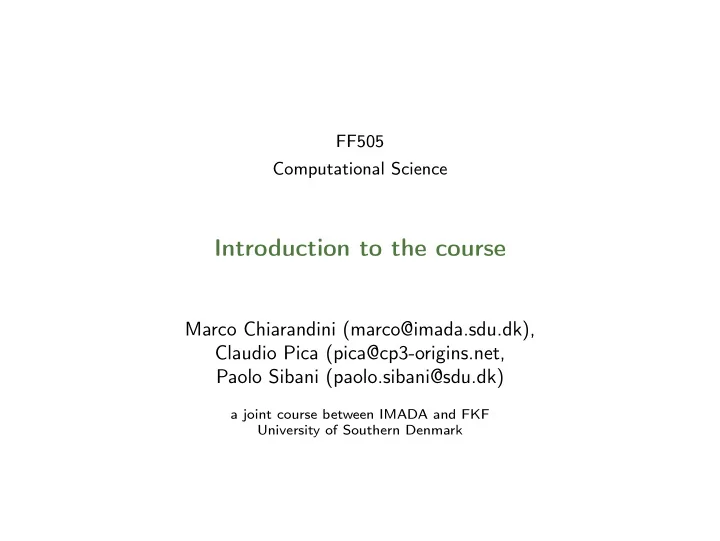

FF505 Computational Science Introduction to the course Marco Chiarandini (marco@imada.sdu.dk), Claudio Pica (pica@cp3-origins.net, Paolo Sibani (paolo.sibani@sdu.dk) a joint course between IMADA and FKF University of Southern Denmark
Course Organization Outline 1. Course Organization 2
Course Organization Outline 1. Course Organization 3
Course Organization Aims of the course To learn to use the computer as a tool for scientific reasoning and discovery To learn how to solve numerically problems that can be solved analytically To equip you with tools you may need when analytical solutions are not known To learn to reason on the meaning of the results found 4
Course Organization Organization of the Course 1. Introduction to a numerical computing environment, MATLAB (Marco Chiarandini) weeks 5-7 2. Introduction to mathematical tools, Linear Algebra (Vincent Drach and Claudio Pica) weeks 5-7 3. Applications in physics (Paolo Sibani) weeks 8-12 4. Training sessions (Martin Hansen) weeks 5-12 5
Course Organization Contents of the course Mathematical Tools: Matrices and vectors: matrix calculs Matrix inversion and determinants Eigenvalues and Eigenvectors Ordinary differential equations Coupled differential equations Lattice Laplacian Fourier analysis 6
Course Organization MATLAB Section The MATLAB Section will cover interactive environment vectorized operations programming: control structures, script, functions data input/output graphics More specifically, it should prepare you to carry out the calculations needed in the other parts of the course and in the project. 7
Course Organization Communication tools BlackBoard (BB) (link to MATLAB Section http://www.imada.sdu.dk/~marco/FF505 ) Announcements in BlackBoard Discussion Board in (BB) - allowed anonymous posting and rating Write to instructors and to Marco or Paolo Ask peers You are welcome to visit me in my office in working hours (8-16) � It is good to ask questions!! � Please, let us know if you think we should do things differently! 8
Course Organization Hands on Experience The course assumes active participation to classes: Introductory classes: you will be asked to perform small tasks at the computer. Training sessions: weekly exercises to be carried out in your study group before the classes. For the MATLAB part, slides and exercises are available at http://www.imada.sdu.dk/~marco/FF505 You are also recommended to document your progress in a personal log-book, which contains your thoughts, calculations, figures etc. 9
Course Organization Assessment Project in the last part of the course similar to those you will do with Paolo to be carried out in groups of two persons hand in a written report, you should attempt to argue your case: Why should the examiner or anybody else trust your results? Individual oral exam based on the written report Graded with external censor according to 7-grade scale 10
Course Organization Some Practical Stuff Getting Matlab: machines in IMADA terminal room have Matlab R2014a installed (type matlab from command line) Install the free Trail version in your computer see link from MATLAB section page. wait for SDU Site-License remote connection (see note on web page) use a Matlab clone, eg, Octave, SciLab use other software for similar purposes: python buy the student edition of Matlab: (ca. 600 DDK) see link from MATLAB section page. 11
Course Organization Who is here? 22 registered, 27 in BlackBoard... how many are here? Student presentation: Name Which programme are you attending Physics Applied Mathematics Guest student 12
Course Organization Unix Operating System In Linux and MacOsX. In Windows via CygWin: The command shell Commands: ls, ls -l, cd, ., .., ~, pwd Manuals: man ls Commands: cp, mv, rm, rm -r displaying content: less, more searching content: grep access rights editors: vi, emacs, gedit , others like Sublime Text can be installed. plenty of useful command line programs: http://www.gnu.org/software/coreutils/manual/ Exercise: Create a directory called FF505 and a file named hello.txt . Edit the file and write something inside. Then try to access the file of one of your neighbors. 13
Course Organization MATLAB MATLAB ( ma trix la boratory) is a high-level language and interactive environment to perform computationally intensive numerical computations faster than with low-level programming languages such as C, C++, and Fortran. Developed by a privately held company, MathWorks, 70% located at the company’s headquarters in Massachusetts. Stable release: 2014b Written in C, Java License: Proprietary 14
Course Organization Other similar numerical computing environments with high-level programming language are: Maple www.maplesoft.com (symbolic) – Proprietary Mathematica http://www.wolfram.com/mathematica (discrete mathematics) – [Proprietary] Octave www.gnu.org/software/octave – [General Public License] R www.r-project.org (statistics) – [GPL] Sage www.sagemath.org (discrete mathematics) – [GPL] SciPy www.scipy.org (based on python) – [GPL] ... later a comparison 15
Course Organization Scientific vs Symbolic Computing scientific computing is based on numerical computation with approximate floating point numbers. ( − 1) s M 2 E http://www.mathworks.se/help/matlab/matlab_prog/floating-point-numbers.html symbolic computation manipulates mathematical expressions and other mathematical objects. emphasis on exact computation with expressions containing variables that have not any given value and are thus manipulated as symbols � Try http://www.wolframalpha.com Symbolic computation can be done in MATLAB with the Symbolic Math Toolbox and the MuPAD editor (not installed) 16
Recommend
More recommend